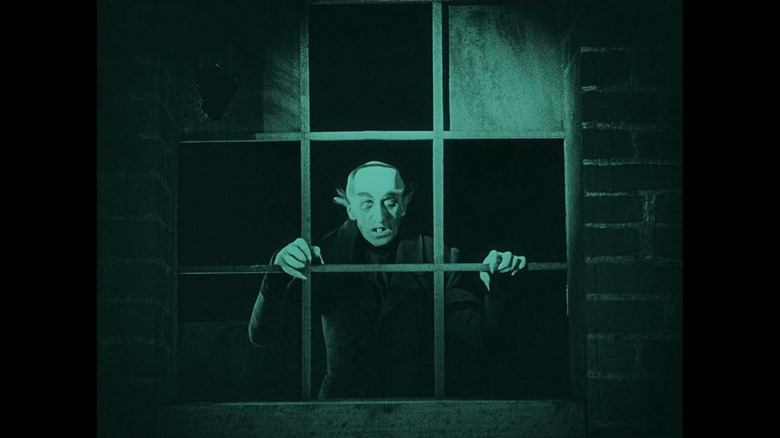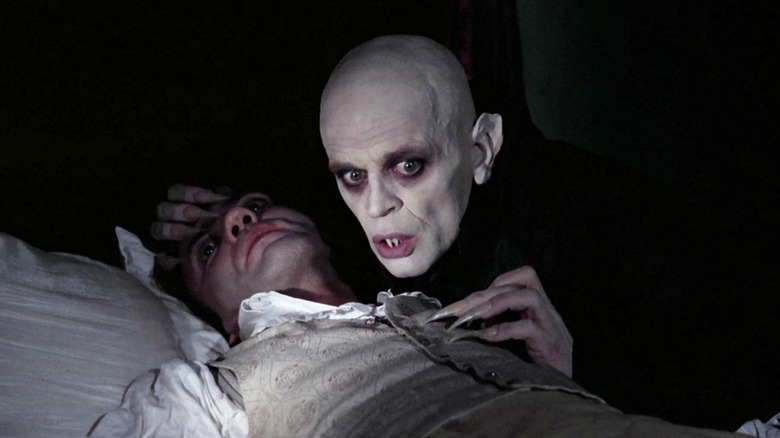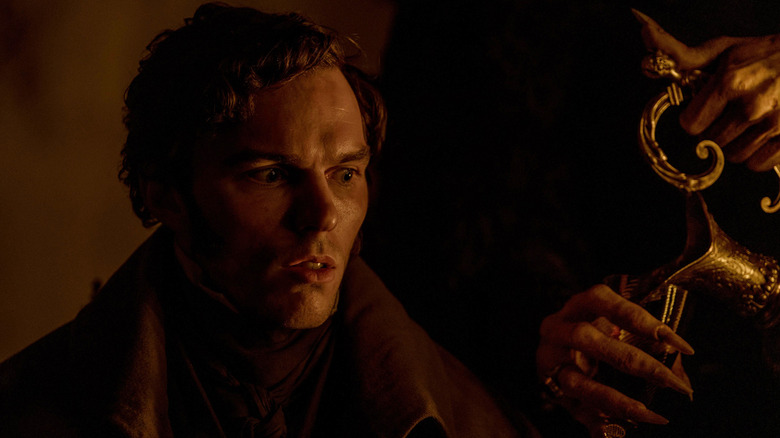
We may receive a commission on purchases made from links.
Robert Eggers’ “Nosferatu” resurrects a 102-year-old vampire who first appeared in F.W. Murnau’s 1922 silent black-and-white film “Nosferatu: A Symphony of Horror.” /Film’s own review of Nouveau-“Nosferatu” raves about it as a truly terrifying horror picture, as scary to modern audiences as Murnau’s was a century prior.
It’s incredible that cinema is now old enough that certain classic films have endured for a century or more. Heck, the 100th birthday of “The Wizard of Oz” is only 15 years away. (In the meantime, you can celebrate the 85th birthday of the technicolor “Oz” with “Wicked: Part One.”) However, “Nosferatu” is technically older than he appears — because the character is, in all but name, Count Dracula.
Now, the vampire himself is not named Dracula in Murnau’s film (nor is he called “Nosferatu,”) but rather Count Orlok (played by Max Shreck). The story follows the major beats of Bram Stoker’s novel, though, aside from moving the setting from England to Germany. Thomas Hutter (Gustav von Wangenheim) — a barely renamed Jonathan Harker — is an estate agent who visits Orlok’s Transylvanian castle. After some time in captivity, Hutter escapes, but Orlok follows him back to Germany across the sea. Orlok nearly ensnares Hutter’s beloved too, but is ultimately defeated. Not with a stake through his cold heart, however, but by the rising sun, creating a now archetypal vampire weakness.
Werner Herzog’s acclaimed 1979 in-color remake, “Nosferatu the Vampyre,” dispels pretense that the movie isn’t a “Dracula” adaptation and uses Stoker’s character names (but also Murnau’s German setting). Klaus Kinski’s Nosferatu looks like Max Shreck’s bald elfen Orlok, but he’s called Dracula. Eggers’ movie, on the other hand, goes back to Murnau’s invented names.
If none of the vampires in any iteration of “Nosferatu” are actually named “Nosferatu,” then why did the title stick? It’s because the word itself is intrinsically tied to Stoker’s “Dracula” novel, which popularized its association with vampires.
Thanks to Dracula, Nosferatu means ‘vampire’
In Bram Stoker’s “Dracula,” the word “Nosferatu” is presented as an ancient, Eastern European term for “vampire” and is used by the vampire hunter Dr. Abraham Van Helsing as such. After Lucy Westenra is made into a vampire by Dracula, Van Helsing explains to her beloved Arthur both her condition and the danger she poses:
“Friend Arthur, if you had met that kiss which you know of before poor Lucy die; or again, last night when you open your arms to her, you would in time, when you had died, have become nosferatu, as they call it in Eastern Europe, and would all time make more of those Un-Deads that so have fill us with horror.”
Stoker apparently got the word from English author Emily Gerard, author of the 1885 book “Transylvanian Superstitions.” Gerard writes of “Nosferatu” as the local word for “vampire” — “in whom every [Romanian] peasant believes as firmly as he does in heaven or hell.”
The word traces back another 20 years to 1865 writings by German writer Wilhelm Schmidt, published in the 1866 book (roughly translated into English) “The Year and Its Days in the Opinion and Customs of the Romanians of Transylvania.” Schmidt’s writing implicitly labels “Nosferatu” as the Romanian word for “Vampire.”
However, the etymology of “Nosferatu” before the 19th century remains shrouded in myth, since it is not part of the Romanian language. In a 2011 edition of the Borgo Post (the newsletter of the Canadian branch of the Transylvanian Society of Dracula), Elizabeth Miller speculates the word could’ve been a “localism that never made it into the Romanian dictionary,” since Gerard does not cite Schmidt and it’s unlikely the two could’ve both made the same mistake.
Other proposed origins of the word include the Romanian word “nesuferit” (“unbearable”) or the Greek word “nosophoros” (“disease-bearing,” which fits the conception of a vampire as a cursed individual who spreads its blight by its continued existence).
Wherever the trail of “Nosferatu” ends, it eventually found its way to Stoker, who used it in “Dracula.” Since “Dracula” is the most famous vampire story ever published, “Nosferatu” became a label for vampires far outside provincial Transylvania. Unlike vampires, language itself is never dead, but constantly changing.
How Nosferatu got tangled in Dracula’s copyright
If you know how “Nosferatu” copied “Dracula,” it’s easy to assume the title change was plausible deniability in the event the copyright fraud was discovered. But dig deeper and the answer doesn’t seem so simple. The “Nosferatu” opening credits acknowledge the film is based on Stoker’s “Dracula,” and “freely adapted” by screenwriter Henrik Galeen.
In “The Nosferatu Story: The Seminal Horror Film, Its Predecessors and Its Enduring Legacy,” author Rolf Giesen suggests that the filmmakers “might have been misled by bad legal advice that they wouldn’t have to pay the copyright owners for the film rights if they changed the story and names considerably.”
As for specifically choosing “Nosferatu” for the changed title? Evidence suggests they just thought it was a scary and alien name, the perfect preface to a film subtitled “A Symphony of Horror.” The Act 1 title card of the film reads:
“Nosferatu. Does not this word sound like the call of the death bird at midnight? Take care you never utter it, lest life’s pictures fade into pale shadows, and ghostly dreams rise from your heart and feed on your blood.”
While Stoker had died in 1912, his widow Florence Balcombe was the executor of his estate until her own passing in 1937. After she discovered in 1924 that “Nosferatu” had been made without her permission, she launched an aggressive legal campaign (through the British Society of Authors) to receive recompense. When production company Prana Film wouldn’t pay (even declaring bankruptcy), the widow Stoker then demanded all “Nosferatu” prints be destroyed. A German judge ruled in her favor, but several copies slipped through the cracks, and so “Nosferatu” survived. (“Dracula” eventually entered the public domain in 1962, rendering proper authorization for any adaptations a moot issue going forward.)
While “Nosferatu” could not exist without “Dracula,” the film has built up a classic reputation all on its own — enough to be remade itself not once, but twice.
“Nosferatu” is scheduled to open in a wide theatrical release on December 25, 2024.




Leave a Reply